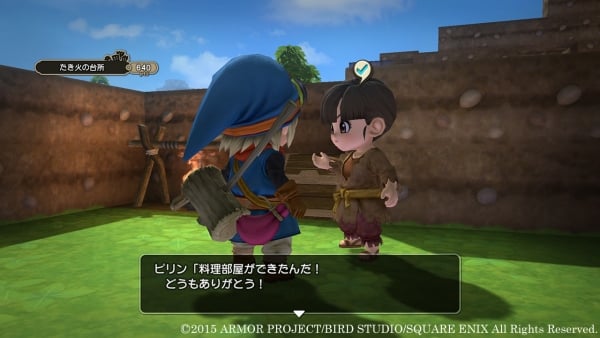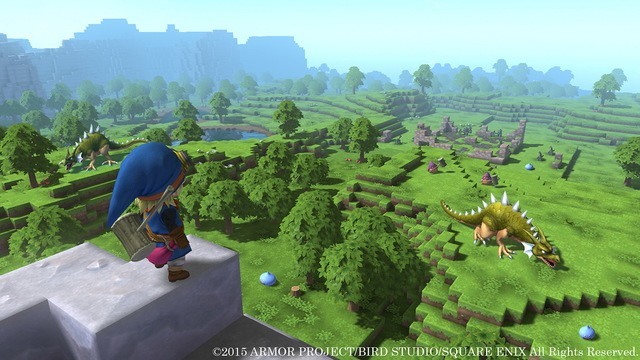Dragon Quest Builders dropped in Japan for PS Vita, PS3, and PS4 last month, and I’ve spent a lot of time with it. While at first glance to many, it may seem like Square Enix is just cashing in on the sandbox voxel crafting genre that skyrocketed to popularity with Minecraft, but this game brings a deep satisfying experience that can even be enjoyed by those who do not typically enjoy sandbox building games. Directed by Kazuya Niinou of Etrian Odyssey, I had high hopes for this game, and I am happy to say I was not disappointed.
Story
The plot of Dragon Quest Builders takes place in the land of Alefgard, the setting of the original Dragon Quest (known as Dragon Warrior in the US for many years). The twist is that this is an alternate reality where the hero from Dragon Quest chose to accept the Dragon Lord’s offer of ruling half the world rather than attempting to defeat him. The hero was betrayed by the Dragon Lord who eliminated him and then set about plunging the world into darkness. Humans were robbed of their ability to create, and their great cities were destroyed. Players assume control of the builder of legend who has retained the ability to create, and is said to be the one who will dispel the darkness shrouding the land. The quest is split into chapters, each of which involve building a base at one of the destroyed cities from Dragon Quest and helping local inhabitants–ultimately leading up to a final confrontation with the boss of the area. Scenarios involve building specific structures at the request of inhabitants, such as hospitals and hot springs, repelling monsters pseudo-tower defense style, and gathering resources to upgrade your equipment. The story is well written and the characters are all oozing with that Dragon Quest charm the series is so famous for.
 Completing quests given by villagers that gather in your town is the key to advancing in the main story.
Completing quests given by villagers that gather in your town is the key to advancing in the main story.
Graphics
The graphics are fantastic, and the colors are bright and vibrant. Toriyama’s signature art style still looks fantastic even with a voxel background, and arguably most importantly they are very distinct in nature from what I associate with Minecraft. I find myself stopping often to look at the small details and views I run across in the process of completing quests. The world is very much a voxel environment however, so if you don’t enjoy this sort of aesthetic the graphics may not impress you no matter how detailed.
From grassy plains and poisoned swamps to freezing tundras and magma-ridden wastelands all of the game’s environments look great.
Sound
The music of the game is mostly re-imagined tracks from older titles, especially the original Dragon Quest, so if you are a fan of the series and Koichi Sugiyama’s work you will not be disappointed. I personally enjoy the music immensely, and it is quite welcome accompaniment when I am gathering materials. Sound effects help give objects you place or strike a feeling of tangibility and weight that helps immerse you in the feeling of building.
Gameplay
Gameplay borrows heavily from voxel sandbox games but differs in what it focuses on. While there is a sandbox mode separate from the main quest, it is only unlocked after progressing a certain amount in the story. Additionally, you will not have access to everything in the sandbox mode until you beat the game. Block collection and placement are similar to Minecraft although blocks are not always the primary location to find materials to progress. There are a large number of non-voxel objects such as plants, rocks, and monsters that serve as invaluable resources required over the course of your adventure.
One of the biggest departures from Dragon Quest Builders’ predecessors is the amount of direction the player is given. Rather than building whatever you want, the game directs you to build to achieve specific goals. You are free in how you build to go about accomplishing these goal for the most part, but occasionally, you will be asked to build according to a specific blueprint you are given. Buildings, once finished, add points to your town which will level up once enough have been collected. Leveling up your town benefits the residing NPCs and is often necessary for story advancement. Certain buildings can give buffs to NPC characters that help you defend your town from monsters and others will be used by NPCs to craft items for you which they will store in a chest.
In each chapter, a series of NPC quests and the ultimate goal of defeating the area boss also help to guide player actions. Coupled with good progression pacing, this led to a feeling of progression that was more substantial than that which I got from traditional sandbox voxel games.
The diagram placed on the ground is the blueprint which can be followed to create a specific structure.
Having never played a voxel sandbox game on any platform other than PC, building controls surprised me with how easy they were to learn. Crafting is done via a simple menu at the correct crafting tool and laying multiple blocks can be done quickly and efficiently by simply holding down the placement button and moving. A special one-time use craftable tool that allows you to convert dirt to sturdier material makes laying out a structure in the fragile material not feel like a waste of time. Speaking of time, a lot of it otherwise spent trudging through familiar territory is saved with the chimaera wing item that allows you to return to your town whenever you want.
The game controls are tight and responsive during combat involving a great deal of spacing and dodging. Weapons include axes, swords, and hammers of standard Dragon Quest fare but eventually you can create ballistas, cannons, traps, elemental projectiles, and a motorcycle-like device with spikes on the front which you ram into enemies. The myriad of weapons give the combat a lot of variety but it especially stands out in its boss design. Each boss has a gimmick relating to something you have learned to create, i.e. for the golem it is a near-indestructible wall. How you build your town and use your creations is the key to victory–just having the best gear doesn’t cut it. This emphasis on what you build rather than gear is a brilliant design choice and one I feel fits perfectly in the spirit of the game. My only nitpick with bosses is sometimes if you have not prepared properly or figured out the gimmick, it can seem like nothing you do is working. There are clues in the bottom-right of the screen on how to damage the boss, but the text is so small I forget it is there sometimes. Trial and error is unpunished though, as you can always reset to before you engaged the boss.
The golem throws boulders that can only be reflected by a certain strong barricade, when vulnerable he must be damaged by magic bombs. The game ensures you will have crafted some of these items and are aware of them before reaching the boss encounter.
Multiplayer
Surprisingly for a game of this genre, no multiplayer aspect is present beyond sharing your creations online. This didn’t bother me as I was playing for the story mode, but I can see it being a deal-breaker for some.
Replay Value
Like others in it’s genre Dragon Quest Builders’ free mode offers you as much replayability as you make of it, no pun intended. Each story mode chapter also has challenges you can aim to meet on a subsequent playthrough. Meeting these challenges can be quite difficult and add an element of challenge for those that desire it.
In Conclusion
Dragon Quest Builders is a solid single-player voxel adventure. It is friendly to veterans of Minecraft and newcomers who have never touched a voxel game before. If you are a Dragon Quest fan, especially of the original title, I highly recommend this game. Even if you aren’t a fan of the series, if you enjoy voxel aesthetic and crafting-centric mechanics there is a delightful adventure to be had.
You Will Like This Game If
- You are a Dragon Quest fan
- You enjoy voxel aesthetics
- You enjoy gathering materials and crafting
- You enjoy games with light story
You May Not Like This Game If
- You need multiplayer in a voxel crafting game to enjoy it
- You do not want to be restricted in what you can build until progressing a story
- You prefer PC controls for navigating a voxel environment
- You enjoy heavy story in single player experiences










Published: Mar 23, 2016 02:08 pm